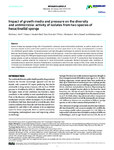Impact of growth media and pressure on the diversity and antimicrobial activity of isolates from two species of hexactinellid sponge
| dc.contributor.author | Koch, MJ | |
| dc.contributor.author | Hesketh-Best, PJ | |
| dc.contributor.author | Smerdon, G | |
| dc.contributor.author | Warburton, Philip | |
| dc.contributor.author | Howell, Kerry | |
| dc.contributor.author | Upton, Mathew | |
| dc.date.accessioned | 2022-01-05T12:34:56Z | |
| dc.date.available | 2022-01-05T12:34:56Z | |
| dc.date.issued | 2021-12-13 | |
| dc.identifier.issn | 1350-0872 | |
| dc.identifier.issn | 1465-2080 | |
| dc.identifier.other | ARTN 001123 | |
| dc.identifier.uri | http://hdl.handle.net/10026.1/18527 | |
| dc.description.abstract |
Access to deep-sea sponges brings with it the potential to discover novel antimicrobial candidates, as well as novel cold- and pressure-adapted bacteria with further potential clinical or industrial applications. In this study, we implemented a combination of different growth media, increased pressure and high-throughput techniques to optimize recovery of isolates from two deep-sea hexactinellid sponges, Pheronema carpenteri and Hertwigia sp., in the first culture-based microbial analysis of these two sponges. Using 16S rRNA gene sequencing for isolate identification, we found a similar number of cultivable taxa from each sponge species, as well as improved recovery of morphotypes from P. carpenteri at 22–25 °C compared to other temperatures, which allows a greater potential for screening for novel antimicrobial compounds. Bacteria recovered under conditions of increased pressure were from the phyla Proteobacteria, Actinobacteria and Firmicutes, except at 4 %O2/5 bar, when the phylum Firmicutes was not observed. Cultured isolates from both sponge species displayed antimicrobial activity against Micrococcus luteus, Staphylococcus aureus and Escherichia coli. | |
| dc.format.extent | 001123- | |
| dc.format.medium | ||
| dc.language | en | |
| dc.language.iso | en | |
| dc.publisher | Microbiology Society | |
| dc.rights | Attribution-NonCommercial 4.0 International | |
| dc.rights | Attribution-NonCommercial 4.0 International | |
| dc.rights | Attribution-NonCommercial 4.0 International | |
| dc.rights | Attribution-NonCommercial 4.0 International | |
| dc.rights | Attribution-NonCommercial 4.0 International | |
| dc.rights | Attribution-NonCommercial 4.0 International | |
| dc.rights.uri | http://creativecommons.org/licenses/by-nc/4.0/ | |
| dc.rights.uri | http://creativecommons.org/licenses/by-nc/4.0/ | |
| dc.rights.uri | http://creativecommons.org/licenses/by-nc/4.0/ | |
| dc.rights.uri | http://creativecommons.org/licenses/by-nc/4.0/ | |
| dc.rights.uri | http://creativecommons.org/licenses/by-nc/4.0/ | |
| dc.rights.uri | http://creativecommons.org/licenses/by-nc/4.0/ | |
| dc.subject | sponge | |
| dc.subject | natural product discovery | |
| dc.subject | hexactinellid | |
| dc.subject | antimicrobial | |
| dc.subject | culture | |
| dc.title | Impact of growth media and pressure on the diversity and antimicrobial activity of isolates from two species of hexactinellid sponge | |
| dc.type | journal-article | |
| dc.type | Journal Article | |
| dc.type | Research Support, Non-U.S. Gov't | |
| plymouth.author-url | https://www.webofscience.com/api/gateway?GWVersion=2&SrcApp=PARTNER_APP&SrcAuth=LinksAMR&KeyUT=WOS:000743262000010&DestLinkType=FullRecord&DestApp=ALL_WOS&UsrCustomerID=11bb513d99f797142bcfeffcc58ea008 | |
| plymouth.issue | 12 | |
| plymouth.volume | 167 | |
| plymouth.publication-status | Published | |
| plymouth.journal | Microbiology | |
| dc.identifier.doi | 10.1099/mic.0.001123 | |
| plymouth.organisational-group | /Plymouth | |
| plymouth.organisational-group | /Plymouth/Faculty of Health | |
| plymouth.organisational-group | /Plymouth/Faculty of Health/School of Biomedical Sciences | |
| plymouth.organisational-group | /Plymouth/Faculty of Science and Engineering | |
| plymouth.organisational-group | /Plymouth/Faculty of Science and Engineering/School of Biological and Marine Sciences | |
| plymouth.organisational-group | /Plymouth/REF 2021 Researchers by UoA | |
| plymouth.organisational-group | /Plymouth/REF 2021 Researchers by UoA/UoA01 Clinical Medicine | |
| plymouth.organisational-group | /Plymouth/REF 2021 Researchers by UoA/UoA07 Earth Systems and Environmental Sciences | |
| plymouth.organisational-group | /Plymouth/Research Groups | |
| plymouth.organisational-group | /Plymouth/Research Groups/Institute of Translational and Stratified Medicine (ITSMED) | |
| plymouth.organisational-group | /Plymouth/Research Groups/Institute of Translational and Stratified Medicine (ITSMED)/CBR | |
| plymouth.organisational-group | /Plymouth/Research Groups/Marine Institute | |
| plymouth.organisational-group | /Plymouth/Research Groups/Plymouth Institute of Health and Care Research (PIHR) | |
| plymouth.organisational-group | /Plymouth/Users by role | |
| plymouth.organisational-group | /Plymouth/Users by role/Academics | |
| plymouth.organisational-group | /Plymouth/Users by role/Researchers in ResearchFish submission | |
| dc.publisher.place | England | |
| dcterms.dateAccepted | 2021-11-03 | |
| dc.rights.embargodate | 2022-1-6 | |
| dc.identifier.eissn | 1465-2080 | |
| dc.rights.embargoperiod | Not known | |
| rioxxterms.versionofrecord | 10.1099/mic.0.001123 | |
| rioxxterms.licenseref.uri | http://creativecommons.org/licenses/by-nc/4.0/ | |
| rioxxterms.licenseref.startdate | 2021-12-13 | |
| rioxxterms.type | Journal Article/Review |



